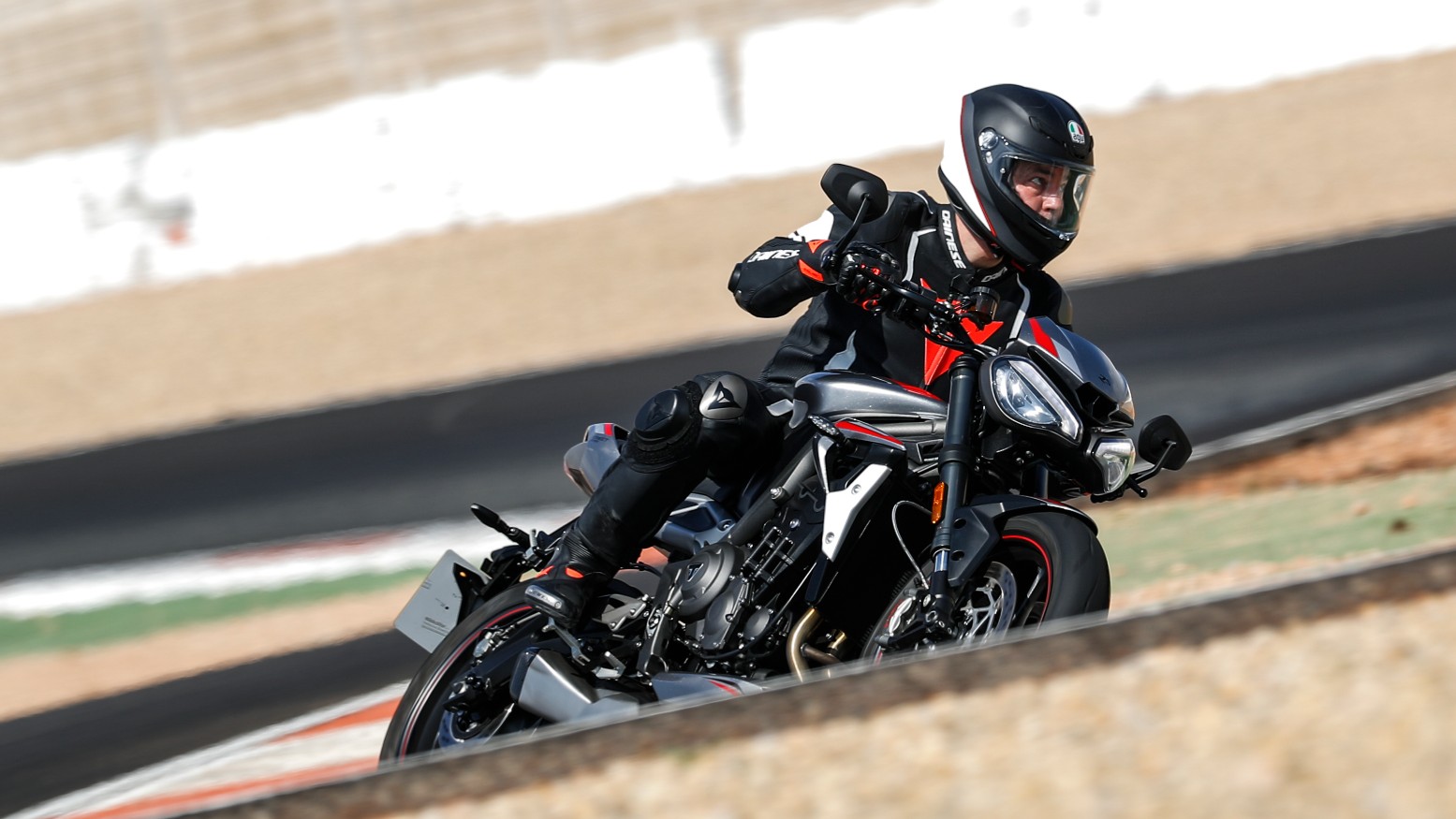
I’ve long said that if my garage burned down and wiped out my small and motley collection of motorcycles and I decided I needed to replace them with one and only one bike, I’d most likely buy a Triumph Street Triple.
In reality, I’d rather have two or three bikes, each more focused: something light and nimble for daily transportation around town, something more comfortable and with wind protection and luggage for traveling, and maybe my now aging Daytona 675 for the odd track day or sport ride, and to sit around looking pretty in between. The Street Triple can do all that, even if it’s not optimized for any single one of those assignments. It’s that competent.
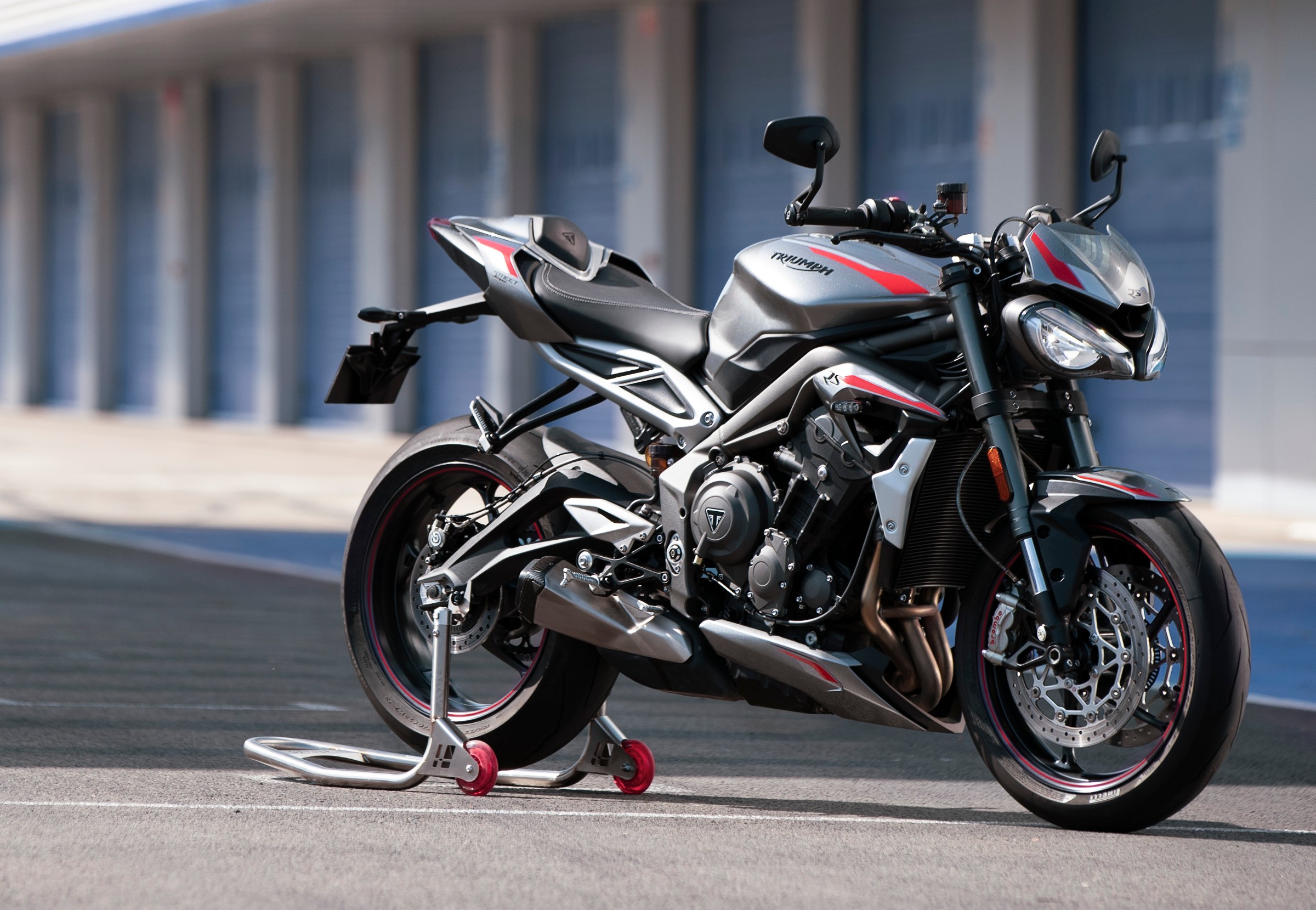
2020 Triumph Street Triple RS. Photo by Kingdom Creative.
For 2020, Triumph has made updates to the Street Triple RS, the highest performance version of the three Street Triple models the British company has produced since totally redesigning the bike for the 2018 model year and moving from the original 675 cc inline triple engine to the 765 cc version that is now the spec powerplant in the Moto2 race series. Of those three, the S was the base model, without the fancy TFT dash, the R was more up-spec but still street-oriented, and the RS offered the highest performance and was most track-ready. Despite its higher cost and more high-strung nature, the RS was the best seller of the three.
I rode the 2018 RS for an afternoon when we had a loaner at RevZilla, and I really enjoyed the bike. But there was no question that the RS had veered further from the “street” part of its name. The power was shifted high in the rev range and though it made plenty of power, there was a flat spot in the torque curve where street riders would far more often find themselves.
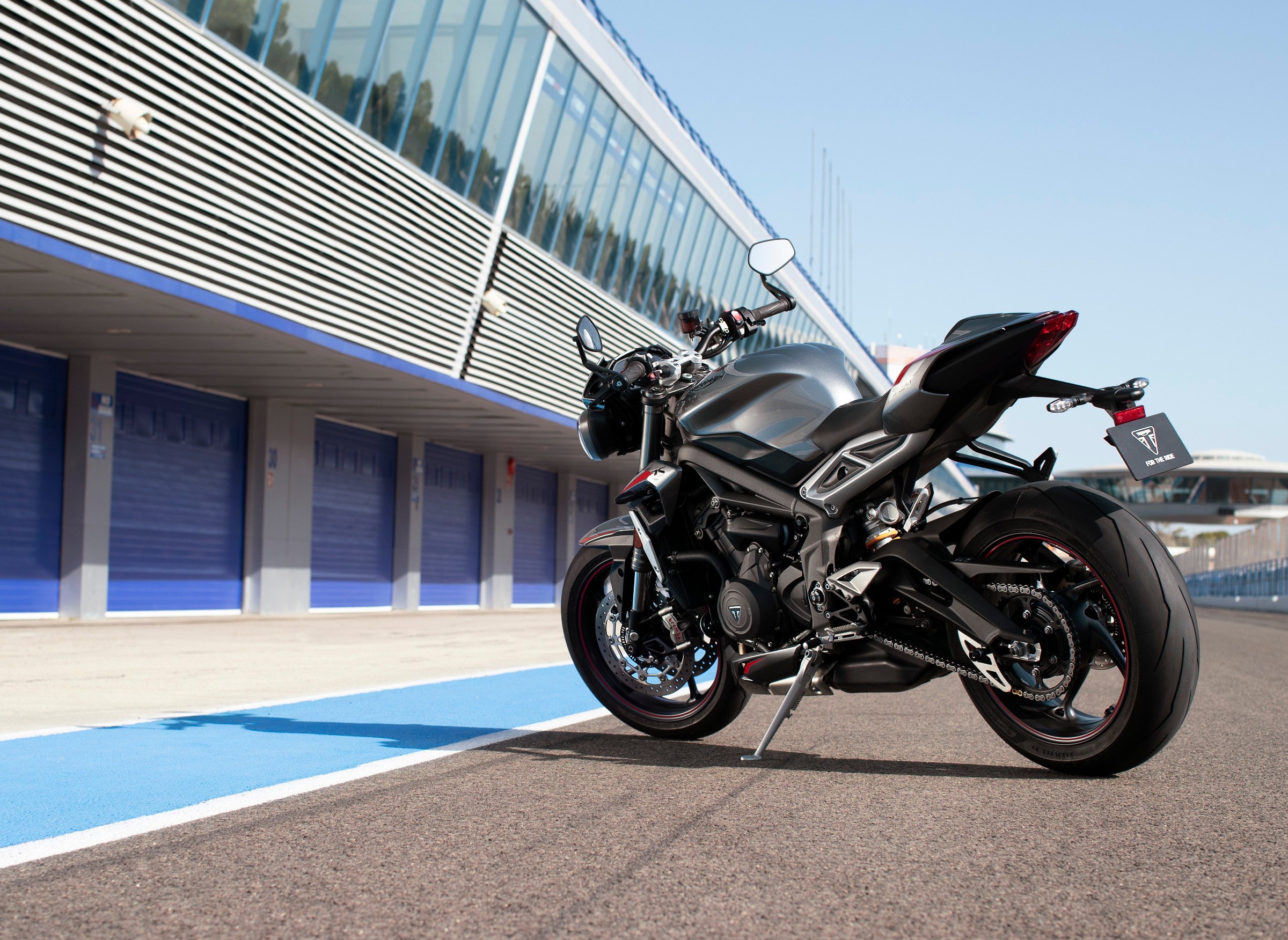
2020 Triumph Street Triple RS. Photo by Kingdom Creative.
So for 2020, Triumph’s engineers set about meeting the conflicting goals of making the bike comply with the newer and stricter Euro 5 emissions standards in Europe, keeping the same peak power and increasing the mid-range power.
“This generation of the RS keeps the best of the RS and takes some of the things that are loved about the R,” said Triumph Head of Brand Management Miles Perkins. “This is the character of the R with all the performance of the RS.”
On top of that, Triumph added a standard feature or two and kept the price the same, at $12,550 in the United States. Sounds promising, right? Last week, I had the chance to ride the 2020 Street Triple RS in Spain on a short road ride and for three, 15-minute sessions at Circuit Cartagena at the world press launch of the new model to see how it worked. It wasn’t very much riding (so my first impressions are limited), but it was very good riding. So let’s look at what Triumph changed for 2020 and how it came out.

Riding the 2020 Triumph Street Triple RS in Spain. Photo by Kingdom Creative.
What’s new on the 2020 Triumph Street Triple RS
Triumph engineers made a variety of changes to the engine to increase mid-range torque. Drawing on experience in developing the Moto2 race engine, internal parts were revised to reduce overall rotational inertia by seven percent, said Triumph Chief Engineer Stuart Woods. For example, by machining transmission parts with greater precision, the engineers were able to remove anti-backlash gears for reduced mass. The intake duct was changed and a new exhaust cam installed that reduces valve overlap, the time both intake and exhaust valves are open in the cylinder. This was combined with a freer flowing exhaust that now uses two catalytic converters to meet Euro 5.
The end result is nine percent more torque at 8,000 rpm, Woods said. Peak torque now arrives at 9,350 rpm, compared to 10,800 rpm on the 2018 version. But peak horsepower is unchanged, Triumph says, still coming in at 121 at 11,750 rpm, which is exactly 1,000 rpm before the rev limiter kicks in.
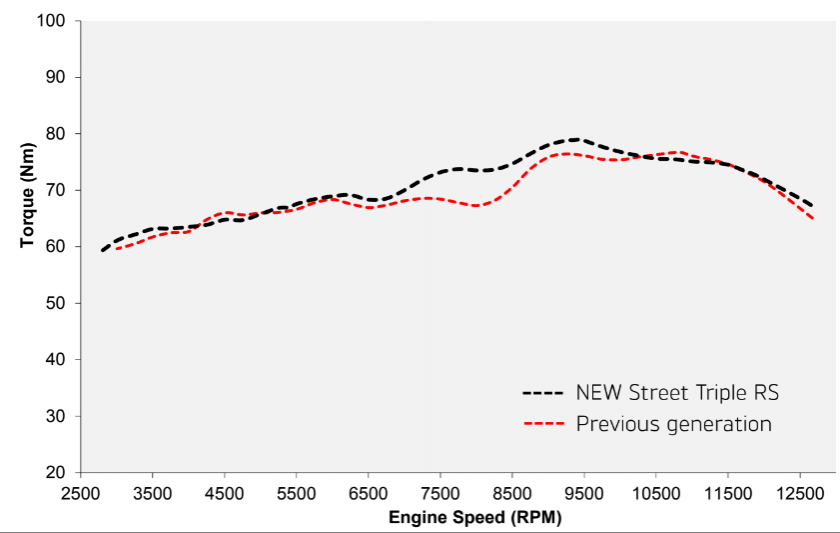
This chart compares the torque curve on the 2020 Street Triple RS to the 2018 and 2019 models. Triumph illustration.
Another change for 2020 is the quickshifter for both upshifts and downshifts, which is now standard on the RS instead of an extra-cost option. Personally, the light pull of the Street Triple’s slipper and assist clutch and the smooth action of its gearbox meant I never longed for a quickshifter, but as is so often the case, I’m out of step with the majority. The quickshifter was a feature widely requested by consumers, said Triumph Head of Brand Management Miles Perkins.
Since the 2020 Street Triple RS is a revision, not a full redesign, there’s much that’s the same, and that’s not a bad thing when you’re starting with such a competent motorcycle. The chassis and suspension are unchanged, with a 41 mm Showa Big Piston fork and an Öhlins STX40 rear shock. The excellent brakes are the same. The Brembo M50 four-piston front calipers are radially mounted and are operated by a lever that is adjustable for both span and ratio of engagement and a radial master cylinder.
The electronic rider aids are the same with five ride modes: Rain, Road, Sport, Track and Rider, the latter of which can be used to set up a customized array of settings to suit your preferences. Rain mode limits power, while the others provide full power. Ride modes affect the throttle map, level of ABS intervention and traction control, but some modes share the same settings, as seen below. Due to regulations, ABS cannot be turned off.
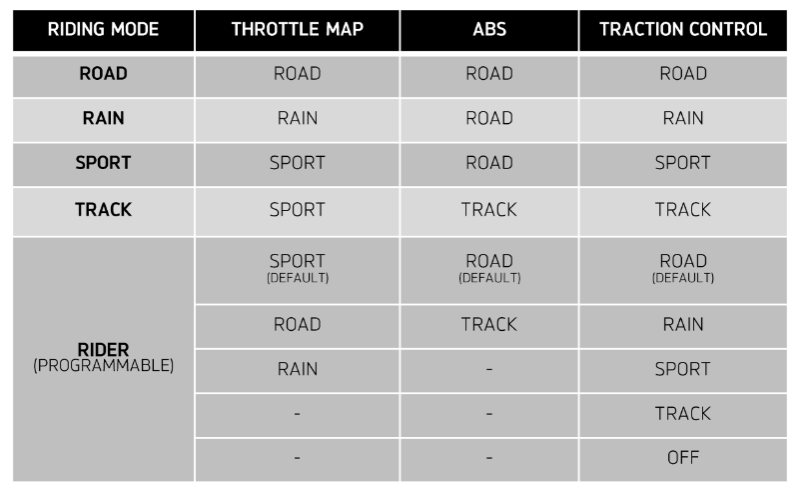
While features like the suspension, brakes and the TFT dash represent quality upgrades compared to some lower cost competitors, there’s one feature the RS still lacks: an Inertial Measurement Unit to allow lean-angle-sensitive ABS and traction control. Perkins said it was not as requested as the quickshifter. Plus, I’m sure Triumph was thinking, “We could add this quickshifter, which we’re already making and lots of people want, or we could add a hugely expensive additional set of electronic controls, which fewer people want.” I don’t think they wasted much time deliberating on that decision. While the Street Triple does sell for a premium over competing motorcycles, Triumph is also sensitive to keeping the price from veering into the outrageous territory. So, no IMU.
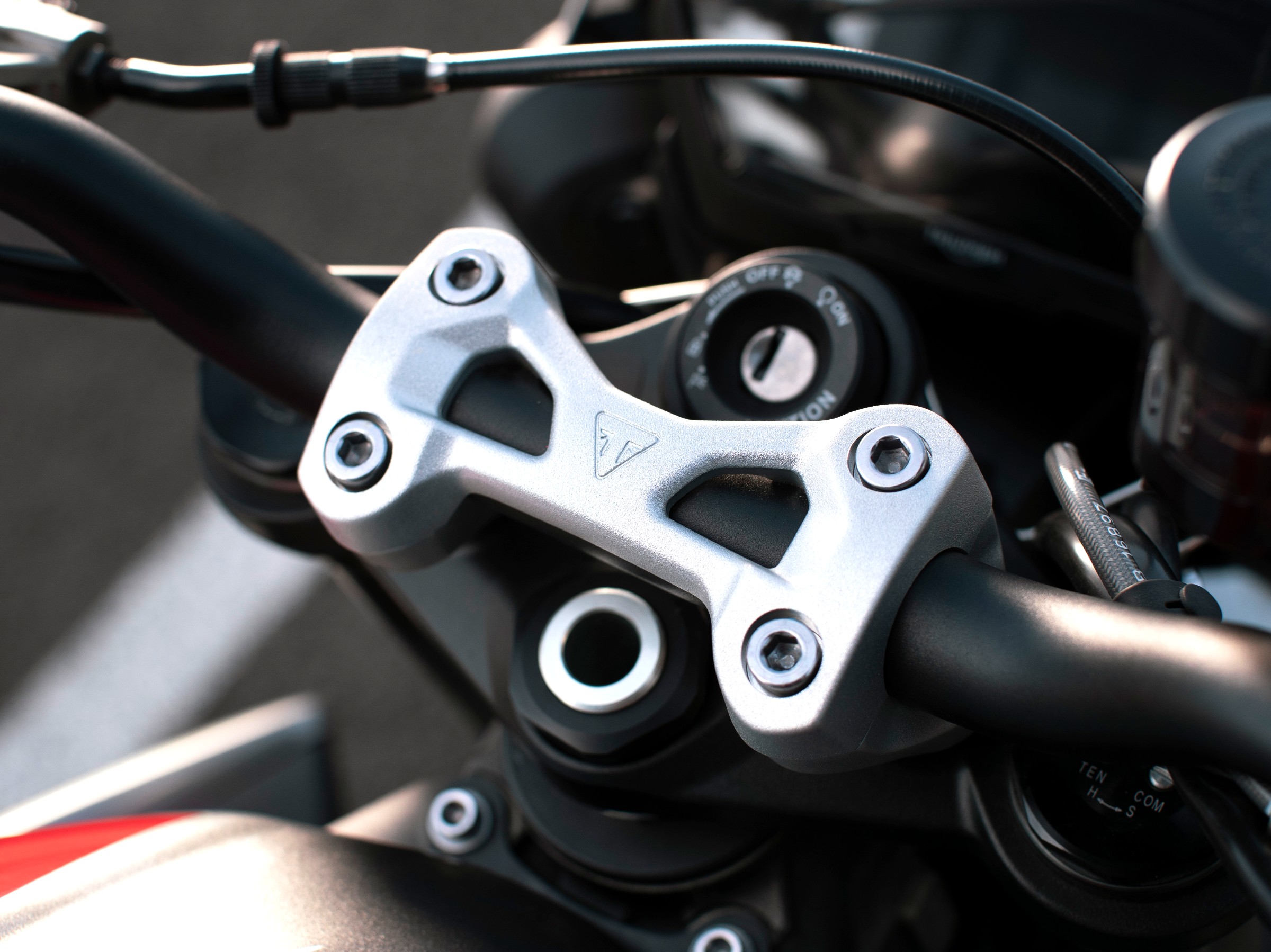
Triumph changed the finishes on a variety of detail pieces on the 2020 Street Triple RS. Photo by Kingdom Creative.
And while I usually don’t talk much about looks, because everyone has their own subjective opinion on that, it should be noted that Triumph did revise the RS’s minimal bodywork. The bellypan and rear seat cowl come standard, the tail section gets the flow-through duct-like shapes that we’ve seen lately on high-performance bikes ranging from the Ducati Panigale V4 to the Yamaha YZF-R6 and numerous appearance details have changed, from the branded handlebar clamp to the carbon fiber trim on the exhaust can.
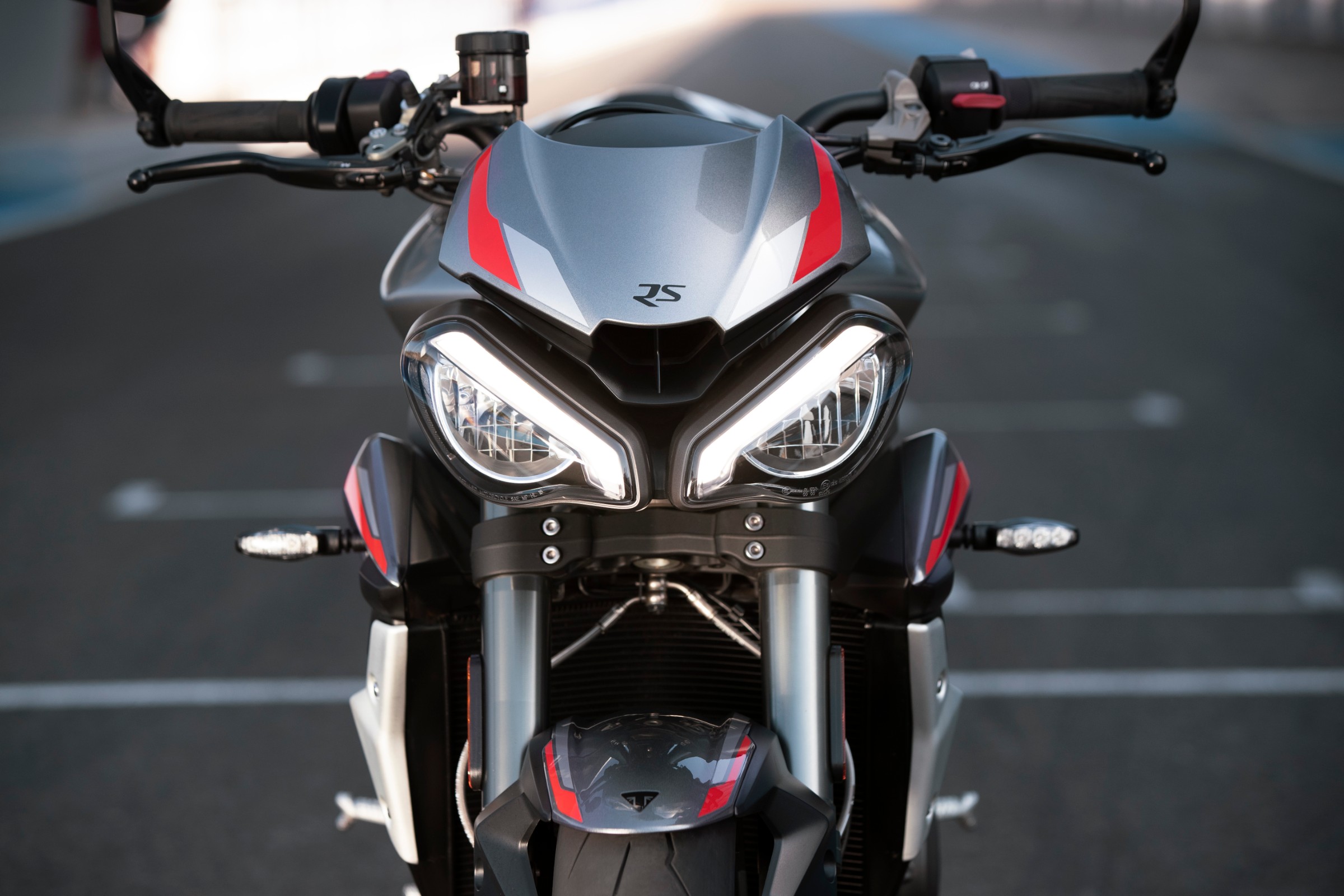
The new face of the Triumph Street Triple RS for 2020. Photo by Kingdom Creative.
More noticeably, Triumph continues to tinker with the Street Triple’s headlights. Traditionalists still long for the round, chrome headlights that debuted on the original Speed Triple back when Triumph invented the factory streetfighter by copying the look of a sport bike that was resurrected after a crash with a handlebar and aftermarket headlights. In 2012, Triumph switched to a more modern shape for the Street Triple’s headlights and the latest version for 2020 incorporates very prominent daytime running lights like furrowed brows over the LED headlights.
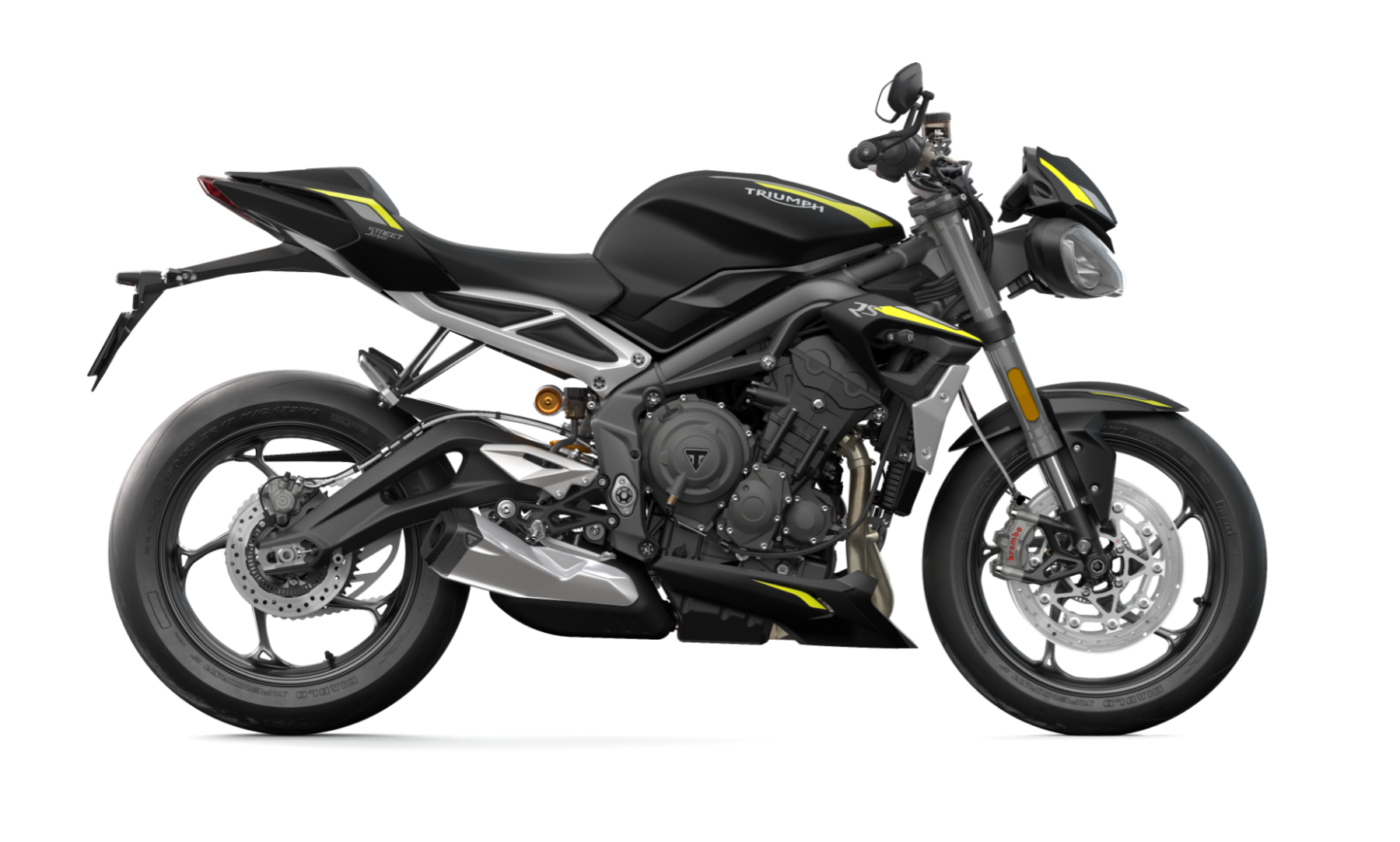
“Matt Jet Black” is the other color option, in addition to the “Silver Ice” version seen in the riding shots. Triumph photo.
Finally, in terms of looks, Triumph is offering two colors for 2020: the “Silver Ice” version seen in the riding photos, which has red decals for accents, and a “Matt Jet Black” version with yellow decal accents.
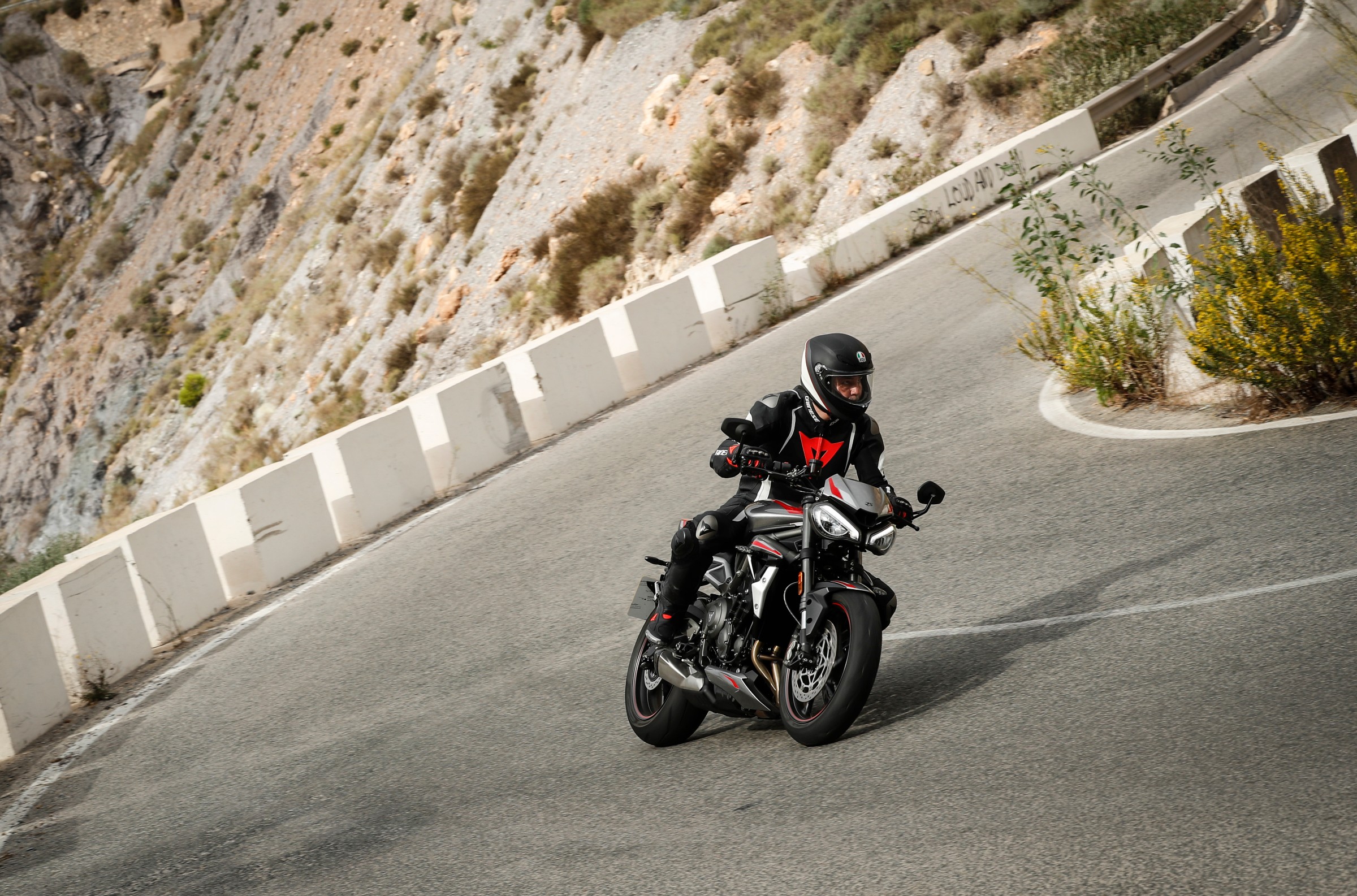
The roads we enjoyed outside Cartagena in Spain were nearly as smooth as the recently repaved Circuit Cartagena track. Photo by Kingdom Creative.
Riding the 2020 Street Triple RS
Press launch rides never provide a lot of riding time, as you have to accommodate a fairly large group of riders, photo stops, an obligtory lunch break, etc. I rode the Street Triple RS a little less than 100 miles, starting with a morning street ride from the Circuit Cartagena race track out to the seaside town of Puerto de Mazarrón and through the Sierra de la Muela, Cabo Tiñoso y Roldán Nature Preserve and back to the track, where we had three 15-minute sessions in the afternoon.
It always takes me a while to feel comfortable with a new bike, but that process is shorter with the Street Triple than just about anything else. Its neutral, natural ergonomics, combined with its lightweight handling, powerful brakes with good feedback, smooth throttle response and slick gearbox make it relatively easy to ride for a bike that offers a high level of performance. Even though the RS is the most high-strung of the Street Triples, it remains a sweet bike to ride.
It’s always dangerous to compare the motorcycle I’m riding today to the one I rode two years ago, especially when I had so little time on both, but my impression was that the improved mid-range on the 2020 RS was significant. I started out in Road mode on the street ride, and then it was time to test the new bike in the one area where I felt the old one came up short. I switched into Sport mode.
My only serious complaint about the 2018 Street Triple RS was the throttle response in Sport mode. It made a powerful but friendly motorcycle feel nervous and twitchy, like someone put too much caffeine in the gas. It was no fun and I saw no advantage to Sport mode, so I just left the 2018 in Road.
Fortunately, that’s not the case with the 2020 RS. Both Sport and Track modes provide the same throttle map (they differ in traction control and ABS settings) and I tried both on the track. Throttle response felt just as smooth as it did in Road mode. Woods told me the difference I was feeling had more to do with the changes to the engine than changes to the mapping of the throttle response, which surprised me a little, but in any case the important takeaway is that the one thing I liked least about the 2018 Street Triple RS has been solved on the 2020.
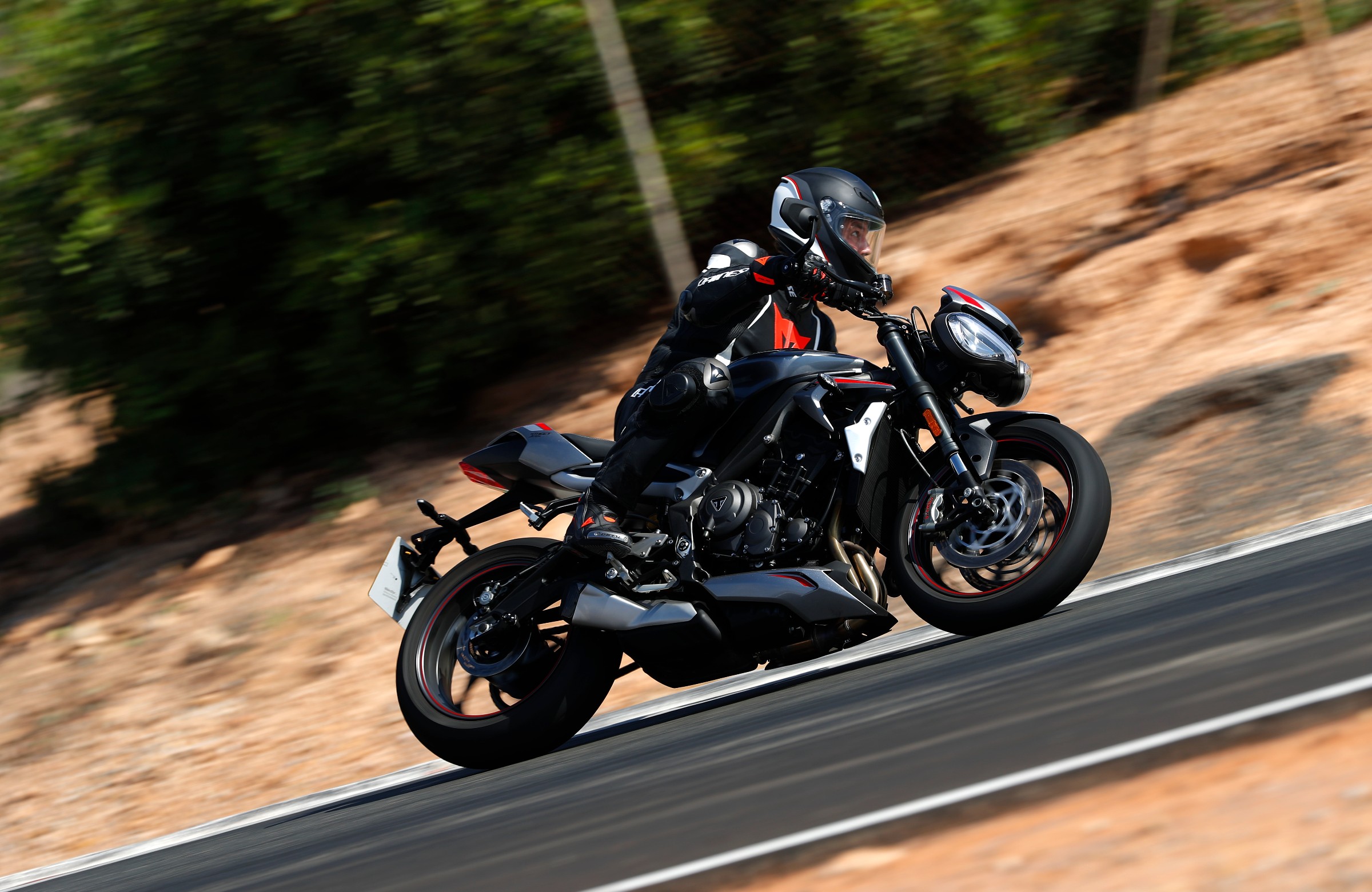
Riding the Street Triple RS on Circuit Cartagena. Photo by Kingdom Creative.
Circuit Cartagena is all turns, with a few modest elevation changes thrown in, and just one straight, so most of the lap was spent in second and third gear. When I talked at the beginning about the Street Triple RS being a bike that can do everything I want to do, I was thinking of this. Its ergonomics are comfortable for street riding, unlike a race replica, but the quality of its brakes, suspension and power make it lots of fun to ride at a track day, too. For a modest track-day rider like me, I doubt I could get around a track significantly faster on a race replica than I could on the Street Triple RS. Faster riders (there were some professional Isle of Man TT racers on hand to lead our street ride and show us around the track) were hampered by the ABS and the ergonomics make it harder to keep the front end planted in 10/10ths riding, but you have to be an advanced rider, probably with some significant racing experience on your riding resume, to be held back on the track by the capabilities of the RS.
The quickshifter everyone else seems to love has never been a high priority for me, but the one on the new RS works well. I could do the entire lap without touching the clutch lever, though like a few other riders I found that downshifts at the end of the straight, while slowing for turn one, went a lot smoother if I used the clutch. A bit of light pressure on the lever was all it took.
If I had one minor complaint about the RS’s performance on the track, it would be a case where I think the designers chose too much form over function. The TFT dash is attractive and functional, and one feature it includes for track use is an adjustable shift light. On my old Daytona, the shift lights are a series of bright white lights across the top of the tachometer, placed high as possible so they’re easy to see when you’re charging down the straight and wondering when to upshift. On the new bike’s dash, a wave of thin blue lines in the middle of the dash flares out and turns orange as you reach the preset shift point. Sorry, but as busy as I am trying not to crash, there’s no way I have the mental bandwidth be looking down for subtle color changes of thin lines. Even in the pits with the bike stopped, I couldn’t figure it out until a Triumph tech explained it.
Meanwhile, the brakes, unchanged, continue to be fantastic and the Pirelli Diablo Supercorsa SP tires gripped tenaciously. It was far too short a day of riding to really evaluate the bike, and honestly, I don’t have the skills of those TT racers that would be needed to really push this bike to its limits. So consider this very much a first impression.
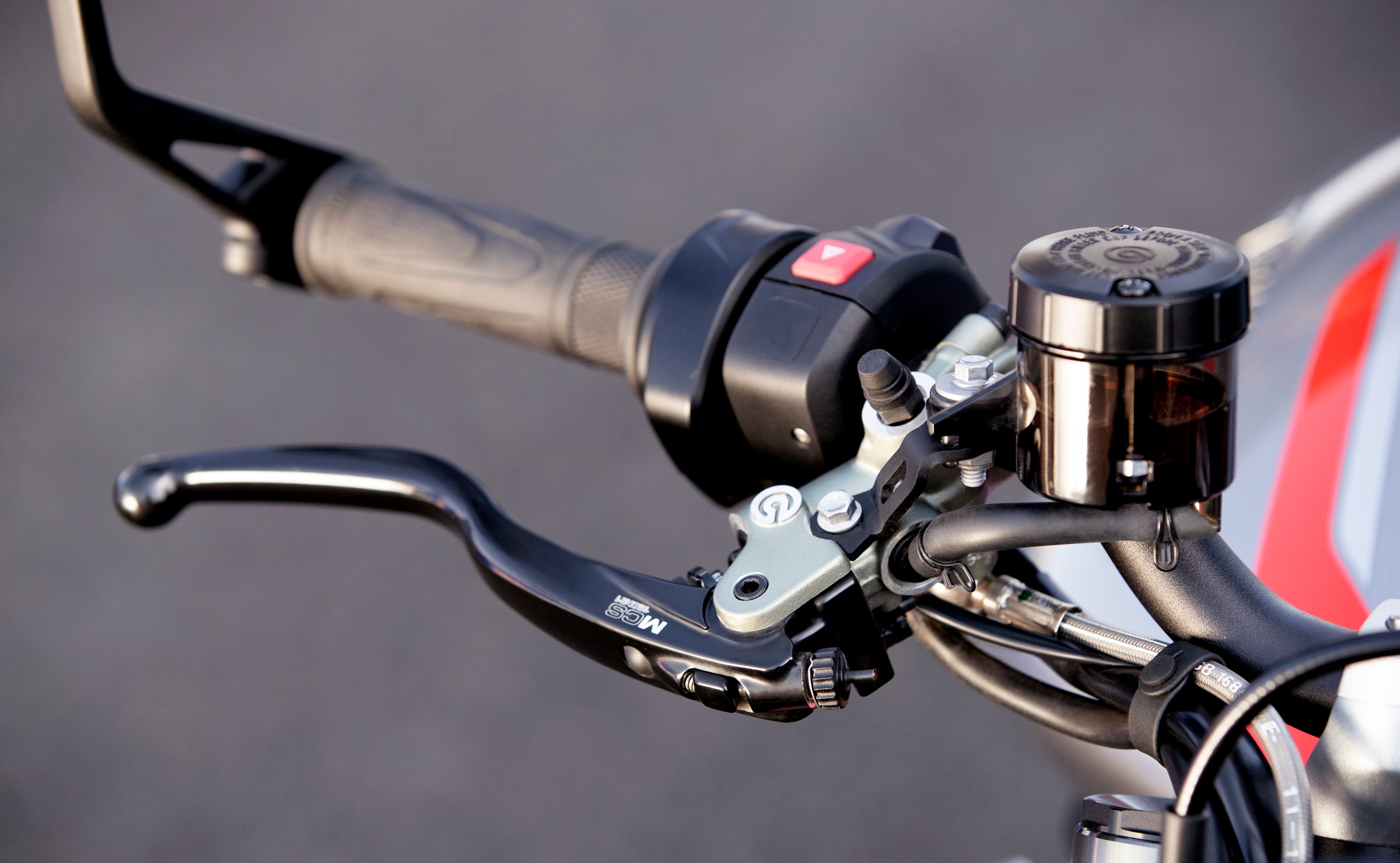
The Brembo brake components on the Street Triple RS are top quality. Photo by Kingdom Creative.
But that first impression is all positive. Triumph took an impressively competent machine and made it better for street use with the enhanced mid-range power, while taking nothing away from the top end, which can be accessed only on the track, unless you’re willing to put your life and driver’s license at risk on the street. The twitchiness of Sport mode is also gone, making all five modes useful. And many riders will feel the Street Triple is improved on the track, too, with the addition of the quickshifter.
The Street Triple RS is not inexpensive, but nor does it ever feel cheap, thanks to its quality components. In fact, because of its versatility, it could be considered a bargain, if you’re in the market for a performance street bike. The Street Triple RS is plenty comfortable enough for a mundane commute to work during the week, lots of fun for weekend sport riding, and fully capable of track days. So it may cost more than some others, but it also could replace two other motorcycles all by itself, if you wanted just one bike to do it all. You know, like if your garage burned down or something.
| 2020 Triumph Street Triple RS | |
|---|---|
| Price (MSRP) | $12,550 |
| Engine type | Liquid-cooled, inline triple, four valves per cylinder |
| Displacement | 765 cc |
| Bore x stroke | 77.99 mm x 53.4 mm |
| Compression ratio | 12.54:1 |
| Torque/horsepower | 58 foot/pounds @ 11,500 rpm; 121.36 @ 11,750 |
| Transmission | Six gears, quickshifter for upshifts and downshifts |
| Front suspension | 41 mm inverted Showa BPF fork; adjustable preload, rebound and compression damping |
| Rear suspension | Öhlins STX40 fully adjustable shock |
| Front brake | Twin 310 mm floating discs, Brembo four-piston radially mounted monoblock calipers, ABS |
| Rear brake | Single 220 mm disc, single-piston caliper |
| Tires front/rear | 120/70ZR17; 180/55ZR17 Pirelli Diablo Supercorsa SP |
| Steering head angle/trail | 23.9 degrees/4.0 inches |
| Wheelbase | 55.5 inches |
| Seat height | 33.1 inches |
| Tank capacity | 4.6 gallons |
| Dry weight | 366 pounds |

I am looking for one motorcycle to do it all, commuting, weekend sport rides and someday I hope a track day. I only have room for one bike so I don’t want to settle and I think its down to the Striple or the Monster 821. Maybe it makes me sound shallow but I like the looks of the 821 better and the TFT dash. Still trying to decide.
That’s definitely a good short list to choose from. The 821 costs about $500 less and gives you the TFT dash but not the quickshifter, if that’s something you want. You can get the quickshifter from Ducati as a $295 option. As for looks, well, you know what you like so you don’t need any help there.
I think the biggest deciding factor between the two is whether you like the nature of the Ducati V-twin or the Triumph triple. For example, I really enjoyed riding the Ducati Supersport S I reviewed here last year, but I wouldn’t buy it because I personally prefer the smooth power of the triple over the more rumbly V-twin. Others love the character of the twin. I don’t know if you’ve had a chance to ride both bikes, but I think that factor would probably make your decision for you.